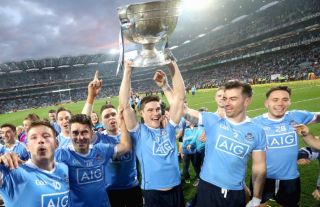The dominance of Dublin football mirrors the imbalances in Irish society

Over Christmas, RTE aired Players of the Faithful, a documentary about the Offaly team that won the All Ireland football championship in 1982. The show was interesting not just to sports fans (or Offaly people) but also those of us interested in the idea of balanced regional economic and social development.
A number of the analysts and past-players interviewed for the documentary noted that the 1982 success came about in large part because of a ‘golden generation’ of Offaly footballers coincided with increased employment opportunities for men in their 20s and 30s in the midlands in 1970s and 80s. Bord na Mona in particular provided an opportunity for young Offaly men to remain in the locality with well-paid work and good career prospects, and eschew - at least for a while - the well-worn path of emigration.
Football fans will tell you there is more to Offaly football’s present woes than the state of the local economy or emigration trends, but the decline in their fortunes and the decline in local employment are probably not unconnected. While Offaly’s three All Ireland championships (1971, 1972 and 1982) coincided with two golden generations and an upturn in the Midlands economy, Dublin football (at both inter-club and inter-county level) has always been very competitive at the high end, in large part because of the significant population residing in the capital and the economic advantages therein.
One of the most remarkable aspects about the Dublin club football scene is the strength and depth of the top clubs. It is not unknown for inter-county players from other parts of the country to sit on the bench at big clubs like Kilmacud Crokes, St. Vincents (Marino), Ballyboden St. Endas, or Na Fianna (Glasnevin); a situation that simply wouldn’t happen in any other county but is indicative of the depth of the talent pool in the capital. Many inter-county players from around Ireland living in Dublin for work have understandably transferred their affiliations to Dublin clubs to avoid a long commute for training and matches. So too have many other players whose ambitions go no higher than the club scene. The result is a glut of talent that not only makes powerhouses of some Dublin clubs and makes the Dublin championship highly competitive (at least at the top end) but distorts the balance of competitiveness within the Leinster and All Ireland club championships towards the capital.
At county level, the Dublin team can train together early on weekday mornings because they have a luxury that no other county football team has: every player on their panel is based within the county. In addition to these logistical advantages, no other county commands anything like the financial resources of the Dublin football team, due to ever-increasing population and the resultant marketing opportunities = something that is a big contributor to their recent dominance of the game.
The slowly creeping imbalance within the GAA towards Dublin in terms of money, talent pool and success is another symptom of an imbalance that is developing socially and economically in Ireland. It is not just footballers who move to Dublin because that is where the jobs are - ordinary people do it too. As GAA players transfer their club affiliations to the capital as part of an overall migratory trend to the region with the best employment prospects and career opportunities, the result in GAA-terms is the loss of local star players or even a struggle for rural clubs to field a team. The socio-economic results are much more severe, as young people leave the provincial towns, villages and rural townlands they grew up in, possibly never to return.
The outcomes are not entirely positive for Dublin either. In the GAA, the problem usually amounts to no more than native Dubliners being deprived of a place on their local club teams. Much more serious is the economic imbalance this migration creates, with a heavy strain on Dublin’s already overburdened transport and accommodation infrastructure. One need only look at the record levels of rental costs and the booming property market in the capital to see where the key issues lie.
Unbalanced economic growth hinders Ireland’s overall potential for economic and social development and has an adverse effect on the overall standard of living within our society. There is a huge social cost to half-empty villages and towns around Ireland while Dublin is thriving to the point where people cannot find affordable places to live or have to deal with long commutes in heavy traffic.
We draw the analogy with the GAA because as an institution it is so central to Irish identity and community wellbeing. And while it can’t be denied that – just like the Irish economy – the GAA is currently thriving, no sporting competition or organisation can fulfil its potential while being continually dominated by the same team or teams, and no society can fulfil its potential with an imbalanced growth path and an over-concentration of resources on one small part of the country.
The imbalance caused by Ireland’s current economic trajectory and the years of austerity after the financial crash has left GAA clubs from Dingle to Dunfanaghy struggling to field teams. The perception that communities all the way up the West coast and around Ireland have been decimated by emigration since the onset of the financial crisis is confirmed by analysis from Social Justice Ireland in previous issues of our Employment Monitor which showed the labour force of many regions in Ireland over the last decade falling significantly, while Dublin is back to where it was 10 years ago (or performing better) by many measures.
A sustainable society requires balanced regional development, both for the sake of the economy and for the sake of social well-being. The proportion of the population of Ireland living in and around the capital city is already very high by international standards, and is growing, and Dublin already accounts for half of all economic output in Ireland. Yet we are continuing to model our growth path, and design our public services, in a way that encourages such concentration. By locating a disproportionate amount of our best health, education, and cultural institutions in Dublin we are driving a model of development that precludes the kind of regional balance required for Ireland to thrive.
This must change, and the government’s National Development Plan must succeed in developing regional social and economic hubs, serving wider regions and creating employment in places that allow people to remain in or near their locality if they wish. This will require - amongst other things - a frontloaded investment to complete the rollout of the National Broadband Plan, and integrated supports for rural entrepeneurs, micro-enterprises and SMEs.
Such balance would be good for the GAA, and good for Irish society.

GIVING A VOICE TO THOSE
WHO DON’T HAVE A VOICE
When you support Social Justice Ireland, you are tackling the causes of problems.
